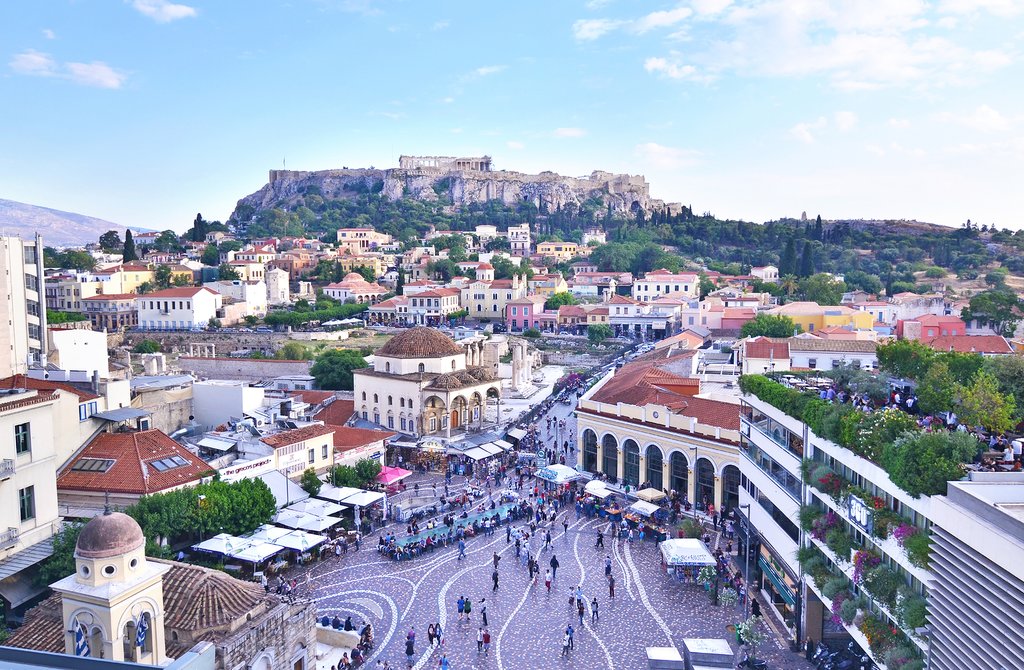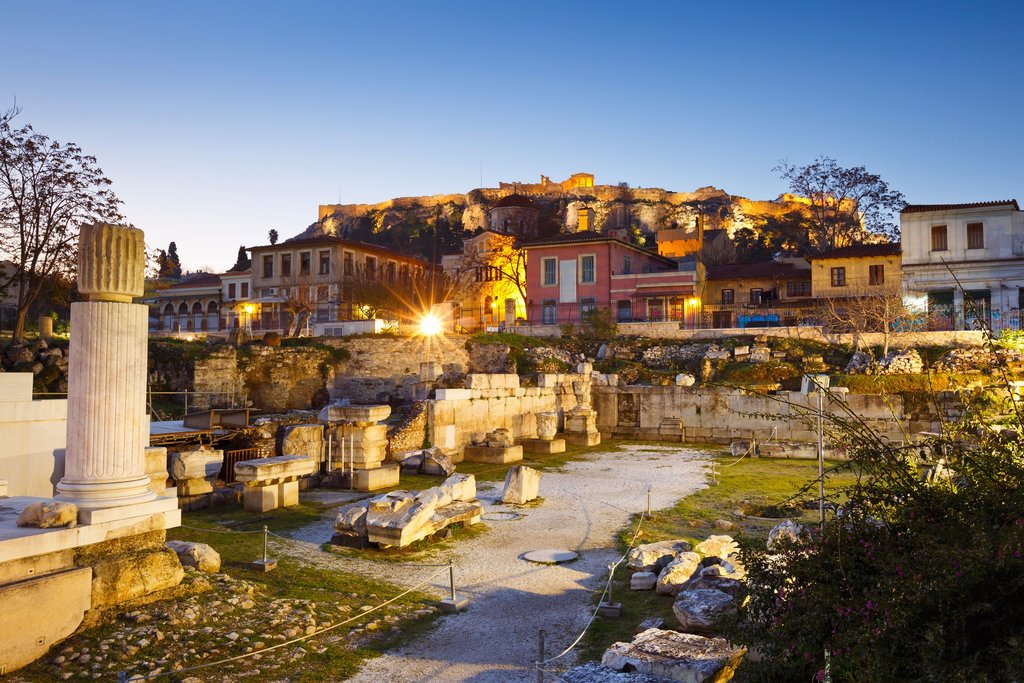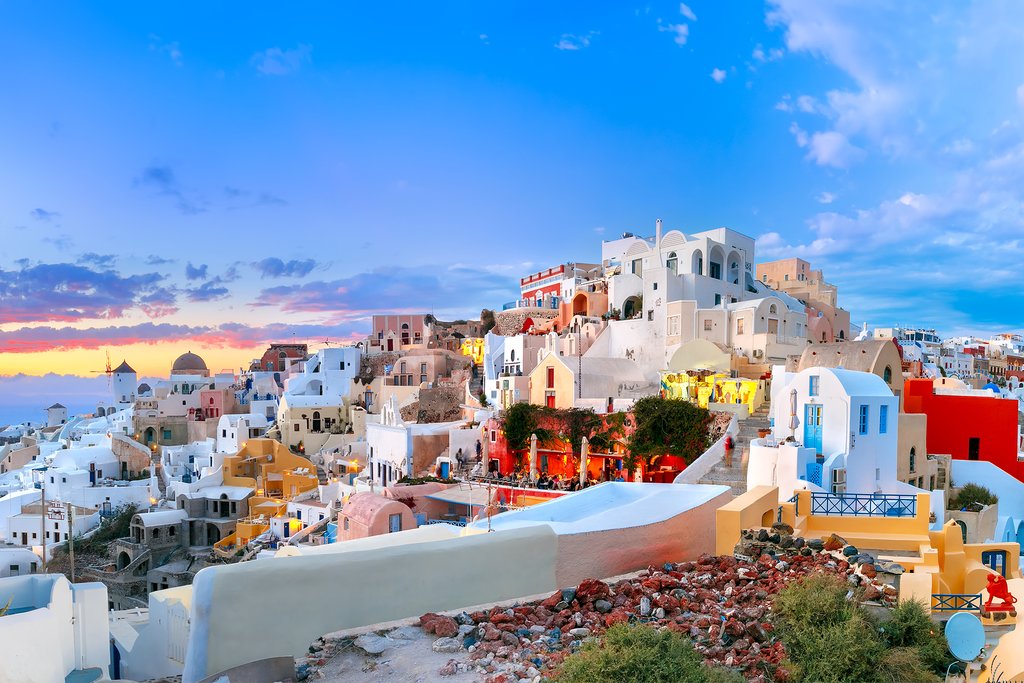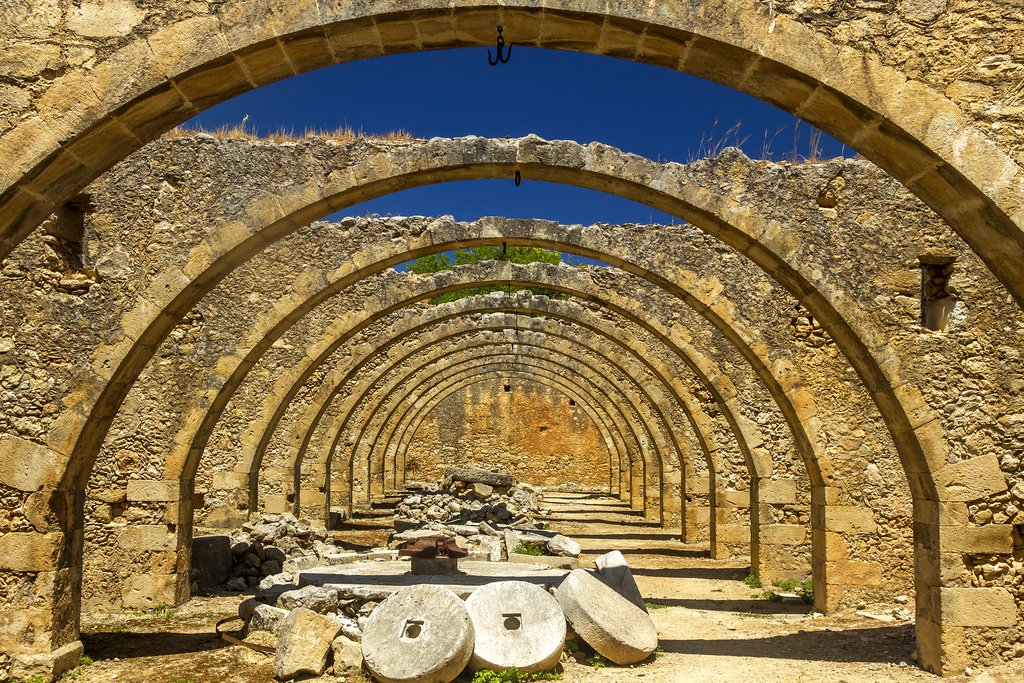Highlights
- See the birthplace of Apollo and Artemis at Delos
- Cruise through the caldera of glamorous Santorini
- Trek the Samaria Gorge in the White Mountains of Crete
- Take day trips to Delphi, Knossos, and Mycenae
Brief Itinerary
| Day | Highlights | Overnight |
|---|---|---|
| Day 1 | Arrive in Athens | Athens |
| Day 2 | Acropolis and Ancient Greek Mythology Tour | Athens |
| Day 3 | Ferry to Mykonos, Farm Visit and Mykonian Dinner | Mykonos |
| Day 4 | Day Trip to Delos | Mykonos |
| Day 5 | Arrive in Santorini, Hidden Gems Tour & Wine Tasting | Santorini |
| Day 6 | Santorini Catamaran Cruise, Ferry to Crete | Heraklion |
| Day 7 | Guided Knossos and Heraklion Tour | Heraklion |
| Day 8 | Travel to Chania, Explore the Villages of Apokoronas | Chania |
| Day 9 | Trek Samaria Gorge | Chania |
| Day 10 | Return to Athens, Sunset at Cape Sounion | Athens |
| Day 11 | Day Trip to Delphi | Athens |
| Day 12 | Visit Mycenae and Nafplio | Nafplio |
| Day 13 | Olive Experience | Nafplio |
| Day 14 | Nafplio to Athens and Depart |
Detailed Itinerary
Day 1: Arrive in Athens

Welcome to Greece! You'll begin your trip in Athens, home to both the iconic Acropolis and so much more. The mythology of this spectacular city precedes it, with towering temples to Classical deities and the ruins of ancient marketplaces rubbing shoulders with lively nightlife, crowded flea markets, and contemporary cuisine. Make the most of your time in the city at some of these spots:
- Check out the views of the can't-miss Parthenon. (Pro tip: The Parthenon is the temple, the Acropolis is the hill.) This temple to Athena has enchanted visitors since its construction was completed in 438 BC. It's probably the first thing that comes to your mind when you think of ancient Greece and is visible from many of the city's high points.
- Stop at the sprawling National Museum for a crash course in ancient iconography. Be sure to seek out the room housing the Antikythera mechanism, essentially an ancient astronomical computer.
- Visit a smaller archaeological site at the Tower of the Winds, then stroll down neighboring pedestrian Aiolou Street to stop at shops and cafes.
- Find your perfect souvenir or sun hat in the busy stalls of the Monastiraki flea market.
Spend your evening exploring the up-and-coming Pangrati neighborhood or amid the nightlife and mezze of the Psyrri district.
Day 2: Acropolis and Ancient Greek Mythology Tour

Experience the ancient stories surrounding you with today's guided mythology tour. You'll meet your guide and storyteller at the Temple of Olympian Zeus, then head to landmarks around the city including the Acropolis, ancient cemetery at Kerameikos, and the Agora. The myths that founded the city and are featured in its retellings for generations will accompany as you go, with stories of Zeus, Athena, Poseidon, Dionysus, and more. Hear both the stories themselves and the historic facts behind them, adding resonance to the archaeological ruins you will visit during this four-hour tour.
Make your way over to explore the Acropolis Museum on your own after your tour (or join a guide if you'd prefer). Named one of the ten best museums in the world by National Geographic, this modern museum houses a multitude of artifacts removed from the hill of the Acropolis for safekeeping to provide insight into ancient religious practices and daily life. Linger for lunch in the museum's cafe, with views of the artifacts' former hilltop home.
As night falls, you may be able to visit the Athens Observatory to learn about the constellations overhead and take a look through the telescope. Its hours vary seasonally and by day of the week.
Day 3: Ferry to Mykonos, Farm Visit and Mykonian Dinner

You'll take a ferry in the morning to Mykonos, one of the most famous islands in the Cyclades. Known for its glitzy restaurants and nightlife, art scene, and jet set crowds (it was recently home to a Gucci pop-up boutique), Mykonos is one of the most quintessential Greek isles.
After getting settled, you'll pay a visit to a traditional farm in the afternoon. Talk to the farm's caretakers to learn about how vegetables are grown on the islands and how the livestock are raised, and even say hi to the animals.
As the sun begins to set, you'll sit down to a traditional dinner. You'll be welcomed into a local Mykonian household for the meal, where you'll experience the traditional Greek way of life, culture, and cooking. Hear all about their stories of the island's culture and history as well as their own family history, over authentic dishes and free-flowing local wine (for the older crowd).
Day 4: Day Trip to Delos

Travel back in time after breakfast with a morning boat ride out to the archaeological site at Delos. You'll board a small boat at the old port to cruise for 45 minutes out to one of ancient Greece's most sacred sites. This small island was the center of the Cyclades during the Classical era and the mythological birthplace of twin deities Apollo and Artemis. Pilgrims from around the region were attracted to the mystical site and helped it evolve into one of the largest trade centers of the Mediterranean.
Your guided tour will wind you through the foundations of former traders' mansions, temples, and landmarks such as the Terrace of the Lions. Don't skip the island museum, where many of the smaller artifacts and frescoes have been moved to protect them from the elements.
You'll return to Mykonos in time to catch up on your shopping in your the afternoon as you explore some of the best boutiques in the Aegean, or check out the weathered Faros Armenistis lighthouse perched high above the Aegean on the island's northwestern tip, with views across to the neighboring island of Tinos.
Day 5: Arrive in Santorini, Hidden Gems Tour & Wine Tasting

Welcome to Santorini! There's nothing like catching your first glimpse of the island's iconic cliffside architecture. Watch for your first views of Santorini's central caldera—the site of one of the largest volcanic eruptions in history—rising up in a crescent.
Spend some time after you've settled in to wander the streets of Fira or get beachside. Don't wear yourself out too soon, though, as in the afternoon you'll take a guided tour which will show you a side of Santorini that most travelers don't see.
You'll start with a stroll through famous Oia, where your guide will point out hidden treasures, followed by a trip up to the highest peak on the island, with 360-degree views at the top for the perfect souvenir photo (or five). Then head on to the medieval villages at Megalochori and Pyrgos, which feel a world away from the touristy towns along the caldera rim. Finally, you'll stop for a wine tasting at the caldera's edge to sample varietals dating back centuries as you watch the sun sink into the Aegean.
In the evening, head back to Oia, passing the Blue Dome of Firostefani along your way. The furthest town along the rim of the caldera, Oia's arty streets are the most famous spot for sunset views, but the evening after the crowds have died down is one of the best times to wander the alleys and linger in the town's tavernas. When searching for your dinner, seek out tomato keftedes, deep-fried tomato balls that encapsulate the essence of the Mediterranean diet, and the Santorini specialty spelt pie.
Chat with a local specialist who can help organize your trip.
Day 6: Santorini Catamaran Cruise, Ferry to Crete

Enjoy a leisurely morning breakfast before taking some time to stroll and scope out small shops and boutiques. Explore Fira, the capital of the island, which offers plenty to check out. History buffs will be delighted by proximity to the Archaeological Museum of Santorini, the Museum of Prehistoric Thera, the Folklore Museum of Emmanuel Lignos, and the church of Hypapante.
As the day unfolds, you'll head toward Vlychada Port to board your semi-private catamaran cruise around the island. Your first stop will be at the Red Beach to swim and sun, followed by a second stop at the White Beach to take in all the distinctive-colored sands of Santorini.
Barbecue will be served onboard while you sail past landmarks at Aspronisi, the Ancient Lighthouse, Indian Rock, and the prehistoric city at Akrotiri, hidden away at the southern tip of Santorini. These ruins are the site of some of the Bronze Age’s most advanced settlements, which prospered for centuries before being destroyed by a great volcanic eruption in the mid-second millennium BC. Top it off with a jump into the hot springs at Nea Kameni, where the mineral-rich volcanic waters are believed to have therapeutic properties.
Once you return to port, you'll be transferred to your ferry to Crete, the largest and most populous of the 230 inhabited Greek islands, and its capital city of Heraklion.
Day 7: Guided Knossos and Heraklion Tour

Set off for a guided exploration of the magnificent Palace of Knossos. This 3,500-year-old Minoan palace is a sprawling maze of royal chambers, grand staircases, storerooms, and workshops. The evocative Bronze Age site is believed to be Europe's oldest city; it flourished for nearly 2,000 years as an economic center, trading with cities across the Mediterranean.
Follow it up with a guided stroll through the streets of Heraklion, exploring the old city's medieval streets with architecture representing the island's Venetian past. Highlights include the elegant arches of the Loggia, now in use as the town hall, and the Koules Venetian fortress along the harbor walls. In the afternoon, don't miss the Archaeological Museum, home to one of the largest collections of Minoan artifacts in the world.
Spend the evening strolling with the locals through the old town of Heraklion. A pleasant pedestrian street connects the port area with the Lions' Square and its Venetian fountain. Don't miss "mama's food" at Anchorage Traditional Mezedopolio nearby.
Day 8: Travel to Chania, Explore the Villages of Apokoronas

Today, you'll continue onward to Chania, a city (and region) on the northwest coast of Crete. Chania itself is the second largest city in Crete and one of the most scenic spots on an island with stiff competition for that title. Life in this former Venetian city revolves around its charming 14th-century harbor, narrow streets with winding alleys, and colorful architecture influenced by past Ottoman and Egyptian eras.
Once you're settled, you'll have a chance to hear some of the island's history firsthand during a guided tour through nearby Apokoronas. The region's villages—seven of them—are home to a number of sites including an Ottoman fort, historic churches, and a folklore museum. But most interesting will be the conversations you and your guide will have with the local residents of the area.
Some potential highlights include:
- The hillside ruins at ancient Aptera, one of the largest city-states in Crete until it was destroyed by an earthquake in the seventh century, including a Minoan tomb believed to date back to roughly the 13th century BCE.
- Two-aisled churches in Stilos village from the 13th and 15th centuries, along with a limestone fossil once believed to be a fossilized sea siren and a walk along the Kiliaris river to a Venetian watermill.
- A glassblowing factory in Kokkino Chorio.
- The old square of Gavolochori, where you can visit the women's cooperative and see hand-knit lace created using a Byzantine technique or the neighboring Folklore Museum of Gavalochori.
In the evening, check out Chania's waterfront districts of Halepa and Tabakaria. Wander among former tanneries and factories in these off-the-beaten-track parts of town, just past the end of the main promenade.
Day 9: Trek Samaria Gorge

After breakfast, you'll be picked up at your hotel nice and early to explore one of Crete's natural wonders. Set amidst the scenery of the White Mountains is the popular hike through Samaria Gorge. The trek takes approximately five hours to cover the gorge's approximately 11 miles (18 km), most of which are downhill and during which you'll spot flora and fauna of all kinds. As your trail nears its end, you'll descend a gentle slope down to the peaceful beach at Agia Roumeli on the turquoise Libyan Sea where you can take a dip and wash off the trail dust.
There will be time to linger on the sand and relax before you wrap up the outing with a boat trip to Chora Sfakion, where your coach will be waiting to return you to your hotel in Chania.
Day 10: Return to Athens, Sunset at Cape Sounion

Return to Athens in the morning. After you've settled back into the city, you'll be transferred down to the Athenian Riviera, full of both history and stunning island views. Your adventure will take you along the coast to visit the Temple of Poseidon, while being provided with historical background on the way. The views overlook the Saronic Gulf, with one of the best sunset views Greece has to offer. Sip a complimentary beverage and take in the sunset while you listen to music and immortalize the moment with a Polaroid-style photo.
You'll be transferred back to your lodging in the evening just in time for a late (Greek-style) dinner. Or, if you're not ready to call it a night, you can request a drop-off at some of the most popular beach bars to dance until the sun comes up.
Day 11: Day Trip to Delphi

Today, you'll seek out the oracle during a day trip to the ruins of Delphi, once home to priestesses of Apollo who Ancient Greeks believed could predict the future. After being transferred from your hotel to Delphi (about 2.5 hours from the city), you'll take a guided tour through this sprawling archaeological site, with stops such as the Treasury of the Athenians, the Temple of Apollo, and expansive theater.
Explore the ruins or venture up an ancient footpath once used by worshippers of the god Pan, who started from the temples of Delphi and proceeded to Corycean Grotto for their religious rites, surrounded by the valley of olive trees and views of the Corinthian Gulf and peaks of the Peloponnese on your way.
Outside of the ruins, you'll head to an old town district that used to serve as the leather tanner's district. One of Greece's last bellmakers keeps his workshop here; if you're lucky, he may be on site for a visit. Lunch will be served under the plane trees in the town square, with cheeses, Amfissa olives, and traditional home cooking.
Head indoors after lunch to the museum, a short downhill walk away. Wander through its halls to find the bronze Charioteer of Delphi, marble Sphinx of Naxos, and what may be the first recorded notation of a melody once inscribed on the walls of the Athenian Treasury.
You'll be transferred back to Athens in the late afternoon to rest up or spend the evening out and about in the city.
Day 12: Visit Mycenae and Nafplio

Start the day early with a guided trip back to a true classic. You may recognize Mycenae from its role in Homer's Iliad: It was home to the famous Helen, whose Mycenean husband King Agamemnon led his people to war when she left him for Paris of Troy. See its Cyclopean walls, whose construction method is still a mystery. They got their name due in part to the belief that only the mythical Cyclops would have been strong enough to lift their boulders.
You'll pass through the Lion Gate with your guide to enter the ruins of the city, wandering past the tombs of Aegisthus and Clytaemnestra and the Treasury of Atreus.
You'll go on to Nafplio, one of the prettiest seaport towns in the Peloponnese peninsula and once believed to have been founded by the son of Poseidon. The town was the first capital of the new Greek state after the war of independence in the 1800s. You'll take a guided stroll through the old town, where you'll pass statues honoring significant figures from Nafplio's history, Ottoman fountains, and Venetian architecture along the winding streets, topped off by the Bourtzi Castle in the middle of the harbor.
Later, don't miss the climb up 1,000 steps to see the view from the Palamidi Castle. Spend a relaxing evening wandering the quiet streets or walking along the waterfront.
Day 13: Olive Experience

Greece has been enjoying the benefits of olive oil for centuries, and now you can take part in this culinary tradition. You'll begin after breakfast with a drive out to a rural village roughly 5 miles (8 km) outside of Nafplio. Visit the local owners to see how the olive oil-making process works and learn about its steps, as well as meet some of the farm's other inhabitants with a sheep-milking session.
Next, visit the groves themselves, enjoying a picnic experience underneath the shade of the trees and lunch in a family taverna. If you arrive in the harvest season, your experience will even include picking olives in the orchard alongside the workers.
Head back to town in the late afternoon, where you'll have a new appreciation for your dinner's ingredients. Top it off by buying a bottle of wine in a local shop to take home. You're in one of the most notable wine areas of Greece, after all. Look for an Agiortiko or another native grape varietal.
Day 14: Nafplio to Athens and Depart

Time to say goodbye to Greece! You'll be transferred back to Athens International Airport after breakfast.


